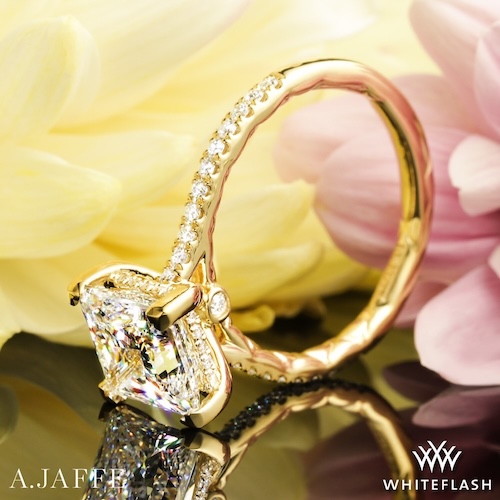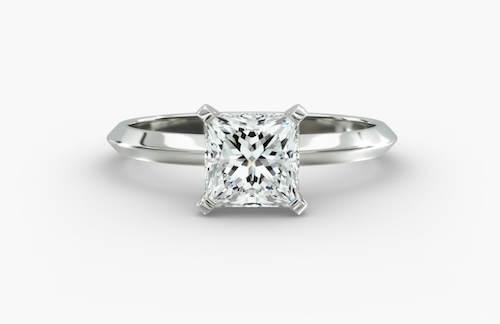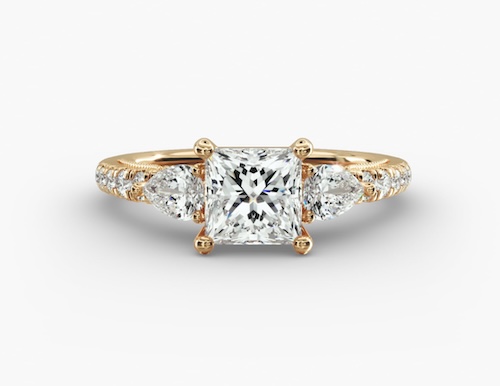This article has mentions of products from one or more companies, and I may receive compensation if you purchase those products following reading my recommendations.
Princess cut diamonds are celebrated for their versatility and sparkle. They are the most popular of all fancy shapes, admired for combining the crisp, modern lines of a square with brilliance that rivals a round diamond.
The cut is widely credited to Betzalel Ambar and Israel Itzkowitz in 1980, though variations trace back to the 1960s. Its roots lie in the French cut — a historical style with just 18–24 facets, designed to shimmer in candlelight. By contrast, today’s princess cut boasts 57–76 facets, crafted to ignite under modern lighting.
French Cut Diamond

Sometimes called a “square modified brilliant,” the princess cut shares a connection with the round brilliant, yet its identity is unique. Its chevron faceting creates lively flashes of fire and scintillation, different from any other cut.
A relatively modern invention with centuries of inspiration, the princess cut is a stone of both tradition and innovation. If you’re considering one, this guide will help you understand its features and ensure you choose a diamond that delivers the best of its brilliance.
How Much does a Princess Cut Diamond Cost?
Like all diamonds, princess cuts are priced per carat. But compared to the ever-popular round brilliant, they tend to be more affordable.
The reason comes down to efficiency. A rough diamond is shaped like an octahedron — imagine two pyramids joined at the base. The pyramid-like structure of a princess cut fits neatly into this shape. A cutter can often fashion two princess cuts from one rough stone with minimal waste. This efficiency is called the diamond “yield.”
Rough Diamond
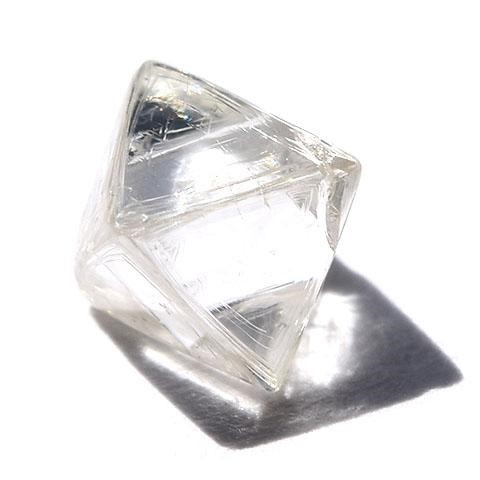
For context: a round brilliant usually retains only about 40% of the rough stone’s weight. So a one-carat rough diamond might produce a 0.40ct round. By contrast, a princess cut can preserve 60%–90% of that weight. More yield means less waste — and a lower price.
Another bonus: because princess cuts are typically cut from well-formed octahedral rough, they often start with fewer inclusions. This means it’s less common to see princess diamonds in the lowest clarity grades.
Of course, price doesn’t rest on yield alone. The true cost of a princess cut will still depend on the quality of its cut, along with color and clarity.
The Cut
Cut quality is the most important factor in a diamond’s beauty, but grading princess cuts has always been trickier than with rounds. There’s no single universal formula for proportions, so buyers often rely on guidelines and performance reports.
The GIA, the leading authority in diamond grading, provides cut grades for round brilliants but not for fancy shapes like the princess. For princess cuts, GIA will only grade polish and symmetry. This means two diamonds with the same GIA report can still perform very differently in terms of light return and brilliance.
Princess Cut Diamond Proportion Guidelines
| Feature | Excellent | Very Good | Good | Fair | Poor |
|---|---|---|---|---|---|
| Table % | 67 – 72 | 59 – 66 or 73 – 75 | 56 – 58 or 76 – 82 | 53 – 55 or 83 – 85 | < 53 or > 85 |
| Depth % | 65 – 75 | 58 – 63.9 or 75.1 – 80 | 56 – 57.9 or 80.1 – 84 | < 56 or > 84 | |
| Girdle | Very Thin to Slightly Thick | Very Thin to Thick | Very Thin to Thick | Very Thin to Very Thick | Extra Thin to Extra Thick |
| Culet | None | Very Small | Small | Medium | > Medium |
| L/W Ratio | 1.00 – 1.04 | 1.04 – 1.05 | 1.06 – 1.08 | > 1.08 |
For years, the American Gem Society Laboratory (AGSL) was the only lab offering a reliable cut grade for princess diamonds, including the coveted “Ideal” grade. In 2022, AGSL was acquired by GIA. While the AGSL lab no longer exists independently, its pioneering cut-grading research and light performance technology have been absorbed into GIA. This expertise is expected to shape how GIA evaluates fancy shapes in the future.
The reality is that most princess cuts are optimized for yield rather than beauty — cutters often shape them to retain as much carat weight from the rough as possible. As a result, true “Ideal” princess cuts remain rare.
For buyers who want the very best, Whiteflash’s A CUT ABOVE® Princess diamonds stand out. These stones were developed using AGSL’s strict light performance criteria and continue to be crafted to the same uncompromising standards today. They represent some of the most precisely cut, visually stunning princess diamonds available anywhere.
The Color
Princess cut diamonds are brilliant, but not quite as bright as round brilliants. Because of this, they don’t hide body color as effectively. Subtle tints may be more visible, especially in larger stones.
The GIA grades diamonds on a scale from D (colorless) to Z (light yellow or brown). Grades G–J are classed as “near colorless” and often strike the best balance between beauty and value.
-
White metal settings (platinum or white gold): Aim for H color or better for a crisp, bright look.
-
Warm settings (rose or yellow gold): An I color diamond usually blends beautifully and offers better value.
Both James Allen and Blue Nile have a large selection of Princess Cut diamonds suitable for a range of budgets. However, if you’re looking for ideal cut Princess Diamonds with brilliant clarity characteristics, then A CUT ABOVE® Princess by Whiteflash is the one for you.
For most buyers, the difference between adjacent grades is nearly impossible to see. Some people are more sensitive to color, so it’s always best to view the diamond in the setting you plan to use.
If your budget allows, stopping at G color is usually the sweet spot. Going higher to F, E, or D dramatically increases cost without delivering a noticeable visual difference.
The Clarity
When evaluating clarity, it’s not just about what you can or can’t see. With princess cut diamonds, durability also comes into play.
The sharp corners of a princess cut are more vulnerable to chipping. If an inclusion sits near one of these corners, it can weaken the structure and increase the risk of damage over time. That makes inclusion placement just as important as clarity grade.
Another factor: princess cuts are typically fashioned from higher-quality rough, so there are fewer lower-grade options (like I1 or SI2) available. SI1 stones do exist, but they often show visible inclusions — and if those flaws reach a corner, they can be problematic.
GIA Certificate on Clarity
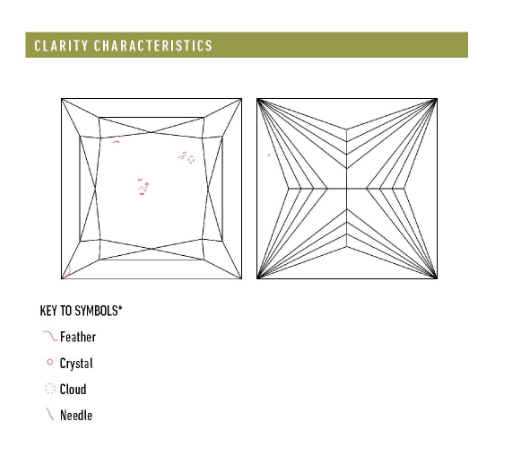
For most buyers, VS1 or VS2 clarity offers the best balance of beauty and security. At these levels, inclusions are rarely visible to the naked eye, and you avoid the durability concerns linked to poorly placed flaws. Always check high-resolution images or the diamond’s inclusion plot on the grading report. Reputable vendors such as Whiteflash and James Allen make this process straightforward.
By focusing on VS1–VS2, you filter out stones with distracting imperfections and keep your attention where it should be — on brilliance, fire, and overall beauty.
Choosing a Setting
I am not in the habit of steering people too strictly when it comes to settings; once you have found your perfect diamond, selecting a beautifully designed setting is truly one of the pleasures in buying jewelry. I must, however, offer some advice when it comes to a claw setting for your princess cut diamond.
In the past I have seen brides-to-be and partners asking for the claws of their setting to be shortened or shaved down. Smaller claws make the diamond look larger as more of its surface is presented.
With a princess cut diamond it is essential that the corners of the diamond are protected, meaning a setting with a more substantial claw is the best way to secure your jewelry (this is especially important in any diamonds weighing 1.00ct or above).
18k Yellow Gold A. Jaffe ME2029Q Classics Diamond Engagement Ring from Whiteflash
Knife Edge Solitaire Engagement Ring In 14K White Gold from James Allen
Lace Bridge Three Stone and Pave Diamond Engagement Ring in 14k Yellow Gold (1/2 ct. t.w) from Blue Nile
And Finally…
Finding a VS1–VS2 princess cut is not difficult. Diamonds in this clarity range are widely available and well-suited for engagement rings. The real challenge is ensuring top-tier cut quality — and that means paying close attention to certification.
Today, GIA is the leading authority in diamond grading. While they do not provide a cut grade for princess cuts, their reports remain the global standard for accuracy and consistency. The AGS Laboratory, once the only body offering a reliable cut grade for princess cuts, was acquired by GIA in 2022. The advanced light performance research pioneered by AGS has now been integrated into GIA’s ongoing work.
In practice, this means buyers should look for diamonds accompanied by a GIA grading report, and where possible, performance data (like ASET imagery) to confirm brilliance and light return. Vendors such as Whiteflash continue to uphold the AGS Ideal standards through collections like A CUT ABOVE® Princess, ensuring precision and beauty even in a post-AGS landscape.
Stick to the recommended grading ranges for cut, color, and clarity, and you’ll secure a diamond that offers exceptional sparkle and value. From there, it’s simply a matter of choosing a setting that elevates your stone into something unforgettable.

